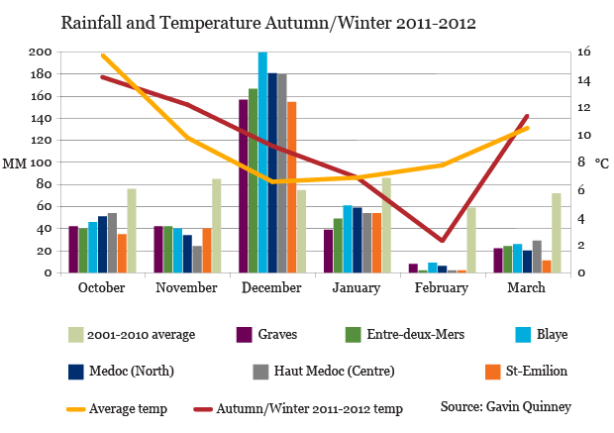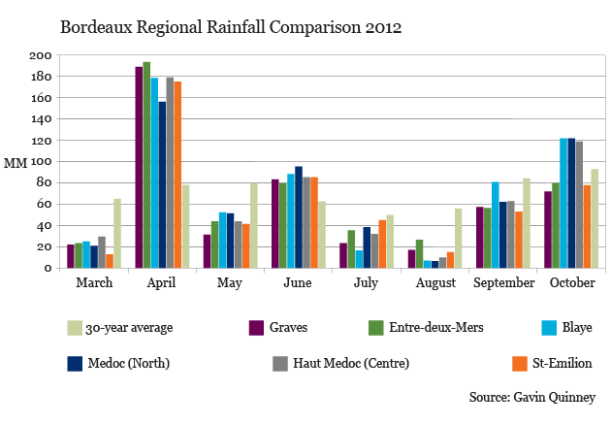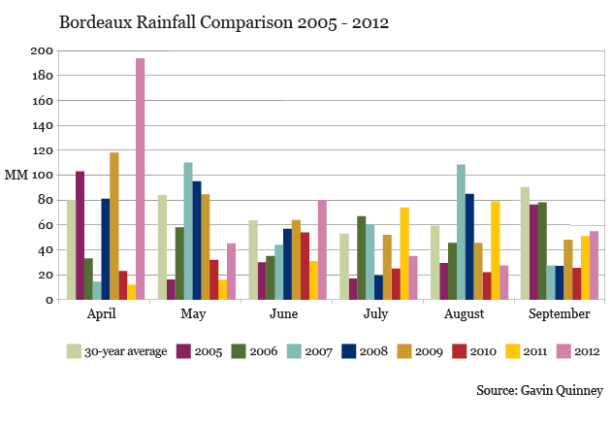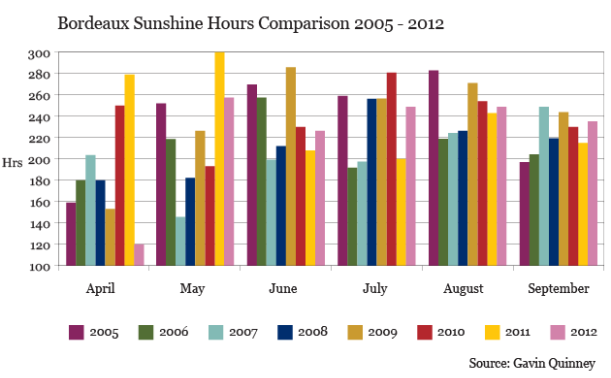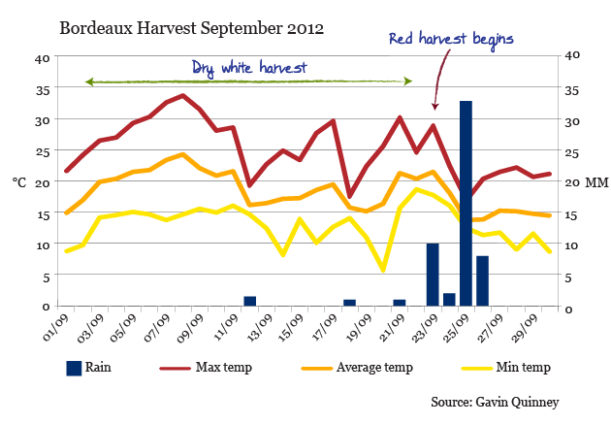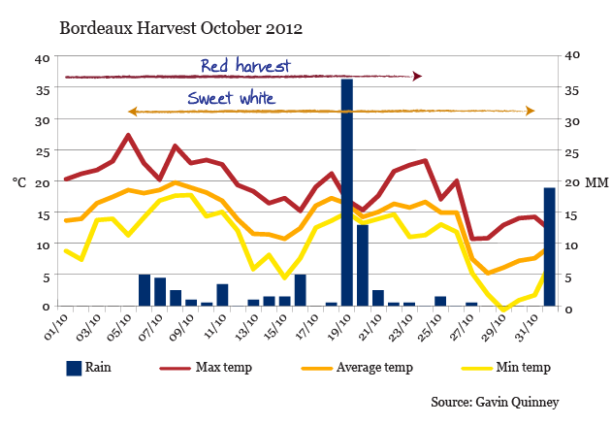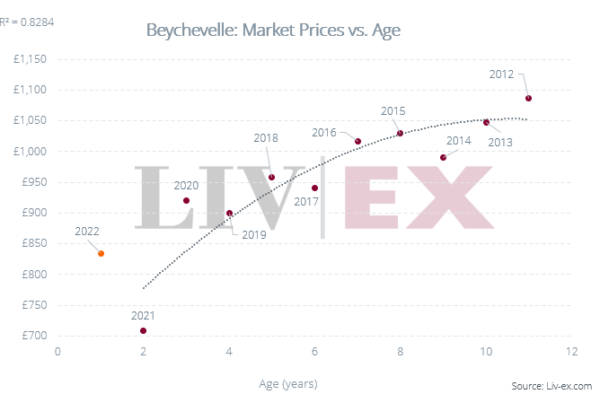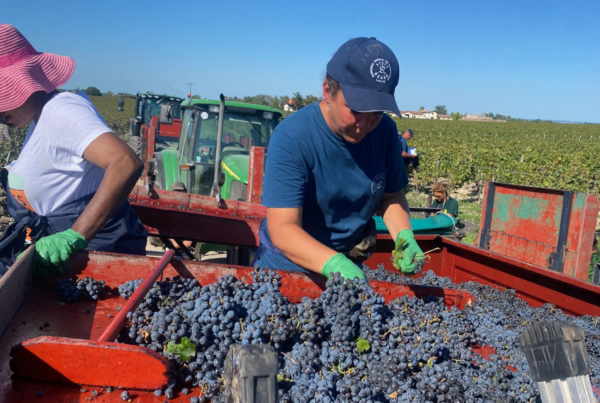Guest
blog: During the Bordeaux 2012 harvest the Bordeaux grower, local winemaker and
writer Gavin Quinney (@GavinQuinney)
provided an insider's view on growing conditions. Here he gives a comprehensive
weather report, comparing conditions for the 2012 with previous vintages.
This
week, wine trade professionals from around the world descend on Bordeaux for
the annual circus of tasting wines from the latest vintage.
When
tasting barrel samples, it can be helpful to have an idea of how the weather
influenced the wine. The weather defines the vintage and, for me at least, it’s
interesting to assess how each Chateau – in fact, the people – handled the
challenges of the season, given their terroir and resources.
I wrote a 2012 harvest report for Liv-ex last
October, and this is my third annual Bordeaux weather report on this blog.
After the two outstanding vintages of 2009 and 2010, it's only normal that
onlookers will compare 2012 with 2011. Yet the weather conditions in 2011 and
2012 could hardly have been more different, even if we like to slot two years
into the same bracket of 'good but not great'.
12 weather highlights in 2012:
1. A late bud-burst and a wet April meant a slow start – the opposite of 2011.
2. Mildew was a real threat and had to be kept in check.
3. Mixed weather in June resulted in the flowering being drawn out.
4. Bordeaux enjoyed an excellent summer from mid-July to late September.
5. August was dry and hot but veraison (when grapes change colour) was spread
out.
6. The dry whites were picked in fine September weather.
7. The weather changed towards the end of September, and October was up and
down.
8. Humid, drizzly weather from 6 October 'encouraged' many to pick.
9. Expensive grape-sorting machines earned their keep.
10. Sauternes had a challenging year, after three great vintages.
11. Yields were low but not as bad as other parts of France.
12. Quality is uneven but there should be some very good wines.
Late winter, late
season
The 2012 Spring bud
break in the vineyard was much later than usual and a full three weeks later
than 2011. Winter was mild until February and the vines didn’t shut down
properly for their much needed winter rest until quite late.
Then we had a bitterly cold February, much chillier than the norm, and the
ground froze. It was to be some weeks before the ground warmed up and the vines
came out of hibernation.
We’d had three dry vintages on the trot (09, 10 and 11) and the winter of
2011-2012 was quite dry. There was a deficit in the amount of water (December
being the exceptional month), with 336mm of rain from October 2011 to
March 2012, compared to 457mm – the Bordeaux average of the previous ten
years.
April showers, summer
drought
After very little
rain in February and March, it bucketed down in April – 194mm compared to a
30-year norm of 78mm – and it was cold too (9.9C compared to 12.4C).
Vine-growth crawled along at a snail’s pace and mildew soon became a huge
threat. May, thankfully, was comparatively dry.
Between March and September 2012, total rainfall was between 420mm and 460mm,
depending on the sector. That’s close to the 30 year average in Bordeaux of
476mm. But what matters is the timing of the rain, and almost half the rain in
this period fell during the month of April. (Irrigation is banned in Bordeaux,
as in other AOCs, so just the right amount of rain and at the right moment is
something we pray for.)
The extremes of the rain in 2012 are shown here, compared to the average each
month. An April deluge, a little too much in June, a very dry summer and then
rain again in the early autumn.
Rainfall compared to recent vintages
The April deluge
stands out (see comments above) but a key period was during the flowering over
a fortnight in the middle of June. The rain in June (80mm here against an
average of 62mm) fell on 12 days from 2 June to 20 June, and it was cold in the
second week too – a critical moment of flowering.
As a result, the floraison was drawn out and fruit set was uneven and
inconsistent. Some vineyards were absolutely fine, although I have rarely seen
bunches of grapes at such different stages of ripening – not just in different
plots but from one vine to another, or even from one vine to another.
Many Merlot and Cabernet Sauvignon grapes were comparatively large but slightly
fewer in number per bunch. One enologist friend reckoned it was because the
vine was allowing for room for expansion in the event of rain late in the season.
If true, this could have an impact on the quality and character of the wine.
It should be noted just how dry it was during July and especially August. This
sets 2012 apart from years like 2006, 2007 and 2011.
These are the rainfall figures for the month (and the 30 year average in
brackets):
April 194mm (78mm) over 24 days with rain.
May 44 (79.8) over 8 days.
June 79.6 (62.6) over 12 days, notably 2/6 and 9,10,11.
July 35.5 (50), 8 days.
August 26.5 (56) 7 days.
September 56 (90) 7 days, notably 25/9 (see below).
September rain was lower than the average and most of the rain came towards the
end of the month (see below).
Note: my figures are from my local weather station, some 15 miles south east of
Bordeaux, except the 'average' figures quoted, which are for Bordeaux itself.
August was hot and dry
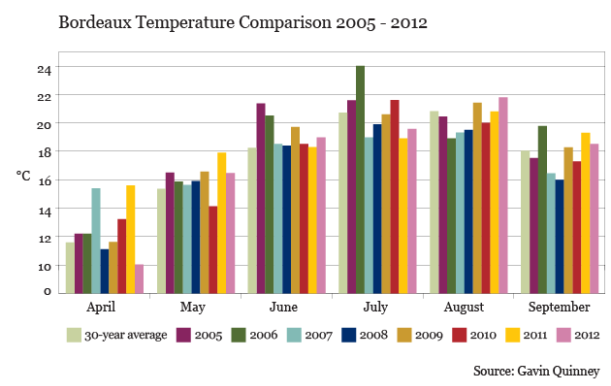
April was not only very wet, but cold, accentuating the slow
start to the growth of the vines.
Here are our monthly temperatures (against the 30 year average):
April 9.9 (12.4)
May 16.5 (16.1)
June 19 (19.3)
July 19.4 (21.3)
August 21.8 (21.4)
September 18.5 (18)
This doesn’t really tell the full story. August, for example, was cool at the
beginning and at the end of the month, but we had 12 days of 30 and over
between 9 and 27 August, with minimal rain. Many vines, especially young ones,
suffered from heat and water stress.
Hours of sunshine
2011 had far more hours of sun in April,
accelerating the early growth that year. However, 2012 had more sun than 2011
in each of the months of June, July, August and September, and this should be
evident in the wines.
2012 compares very favourably to years like 2006, 2007 and 2011 from June to
September, and isn’t far short of the top years. Note how the total hours of
sunshine per month in the excellent years of 2005, 2009 and 2010 stack up, and
how, for example, the weaker vintage of 2007 was saved by September.
Bordeaux 2012 – a fine September
After a hot and sunny August, the fine weather
continued well into September. Sauvignon Blanc and then Sémillon were picked in
excellent weather for the dry whites. The temperature dropped in the second
week, which also proved helpful when harvesting the whites. Dry white, however,
makes up only a small percentage of the harvest in Bordeaux (less than 10%), so
the real money was on the how the reds would ripen.
The weather turned on the weekend of 23 September, and a handful of estates
began picking young Merlots that week.
In 2011, almost all the reds had been brought in by the end of September but in
2012 very little had been picked to this point. It was a huge contrast, and a
reminder of just how the weather controls the vintage.
October harvest for reds
The
red harvest began in earnest in the first week of October on both banks.
Pomerol was largely completed by the end of the week, with the top estates of
St-Emilion only kicking off from Monday 8 October.
The weekend of 7 October proved to be a turning point, as it was both humid and
drizzly, forcing many to bring forward their harvest plans in case rot took
hold. Some had to compromise between harvesting healthy grapes and
physiologically-ripe ones.
Most estates had wrapped up the red harvest by the time of the heavier
downpours on the 19 October. This would have favoured Merlot from the better terroirs
over the later-ripening Cabernets. Having said that, all the Cabernet Sauvignon
I saw being brought in on the Left Bank in mid-October looked in very healthy
condition.
The above rainfall figures are from my local weather station. Rain in Pauillac,
for example, was heavier than here around 14 October to 20 October.
Meanwhile,
it was a difficult year in Sauternes as a result of the drought in the summer
and rain in the autumn, with Yquem, Rieussec and Raymond declaring that they
wouldn't be making a Grand Vin this year.
Personally, I think Bordeaux needed a fortnight of better weather at the end,
but that’s always going to be the risk with a later harvest. It's not that the
grapes were unripe, it’s just a shame that after a marathon growing season and
a fabulous summer in 2012, we limped across the finishing line. The opportunity
to make outstanding wines across the board disappeared as Autumn closed in.

